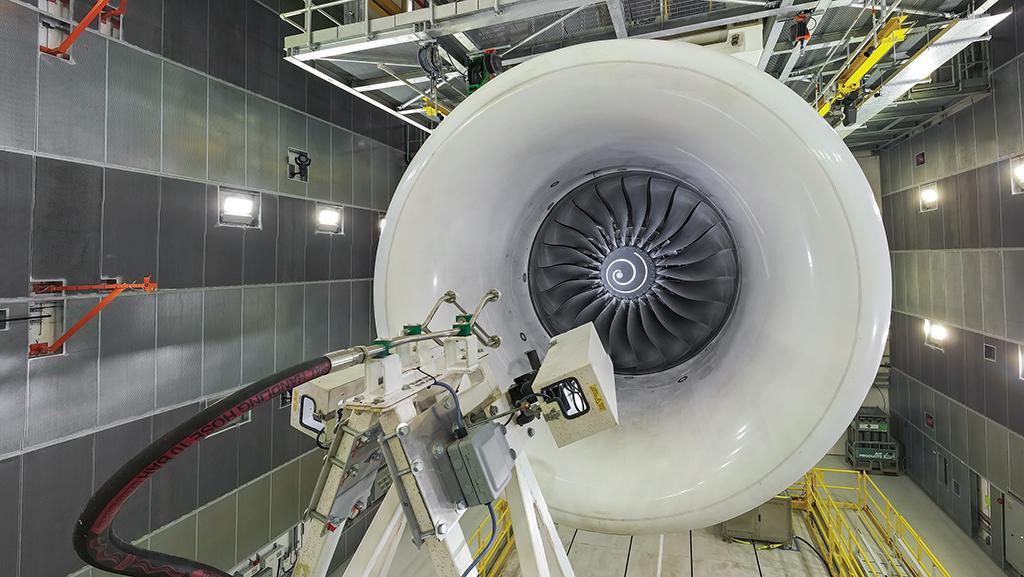
Rolls is putting the Trent XWB-97 through its paces to address reliability concerns in hot and sandy conditions.
Rolls-Royce is preparing to deploy a series of upgrades across its Trent engine family for widebody aircraft in a bid to address long-running customer performance complaints.
Some enhancements have been years in the making and aim to improve the performance of the Trent 1000 powering some Boeing 787s, the Trent XWB used on the Airbus A350 and the Trent 7000 on the Airbus A330neo. The engine changes are part of a £1 billion ($1.3 billion) multi-year investment program Rolls disclosed in February.
- Trent 1000 enhancements aim to boost time on wing
- Airbus A350-900 engine poised for 1% fuel-burn improvement
“We’ve had a number of problems, being open and honest, over the years. Not just us,” says Simon Burr, Rolls-Royce head of engineering. The goal now is to eliminate those uncertainties for customers. “The vast number of hours we’ve built up on the Trent family enable us to sort of focus our upgrades on the things that really matter,” he says.
The engine-maker plans to start flight-testing the latest round of Trent 1000 upgrades in August to address long-standing reliability problems that have frustrated customers and potential buyers. In 2018-23, Boeing 787 customers ordered 677 GE Aerospace GEnx-equipped aircraft versus 71 powered by the Trent 1000, according to the Aviation Week Network Fleet Discovery database.
“We’ve lost market share on this engine because it’s not sufficiently durable,” Burr says.
Rolls is introducing Trent 1000 enhancements made on other engines, including the high-pressure turbine (HPT) on the Trent 7000. Flight testing should last about eight weeks to clear the upgraded engine design for operational use. It is expected to deliver a “step change” in durability, Burr says. The company seeks to double time on wing and plans to make more upgrades for another 30% durability improvement.
Rolls also is wrapping up flight testing of a major upgrade to the Trent XWB-84 that powers the A350-900, Burr says. The effort should allow the engine to run cooler, yielding about 1% improved specific fuel consumption, he says.
The package that includes fan aerodynamic and turbine improvement is expected to be type-certified this year and flying with customers in 2025. The first engines with the new features are now in production, he adds.
The upgrades will be largely available only on new-build engines. Rolls will charge extra for the enhanced configuration but will offer customers the option to buy the earlier configuration, says Ewen McDonald, chief customer officer for Rolls’ civil aerospace unit.
In addition, the engine-maker is introducing a new disk alloy called RR1073 that will be available for the XWB-84 as well as the -97 version used on the A350-1000. The alloy is cleaner, and its homogeneous structure provides greater certainty on performance, which allows the company to be less conservative in parts-life assumptions. The alloy also can run 50K (-370F) hotter, giving it either higher performance or longer life, McDonald adds.
“This will be a step change in life limited part performance at Rolls-Royce,” he says. It should be available in engines in 2025, soon after the other -84 enhancements.
Rolls is working through a series of upgrades to the -97 as well to address a lack of durability in hot and sandy environments. The development is aimed at addressing criticism from customers such as Emirates Airline.
As a first step, Rolls released temperature margin and improved turbine case cooling, which Burr says is already providing better performance. The company plans to start delivering new coatings for HPT blades this year to better deal with the effects of ingested sand and high temperatures.
Rolls is working on more changes, including to the combustor, to create a more uniform thermal profile for the blades using new cooling techniques, Burr says. Tests have shown promising results, he notes. “We’ll at least double time on wing,” he says, aiming for certification in 2027.
The XWB-97 improvements can be introduced on in-service engines, McDonald says.
Rolls also realized temperatures at the interface between the HPT blade and the static seal segment were running hotter than expected, so it is adding ceramic matrix composites to handle the temperature regime. “Controlling that interface, controlling those components will release a huge step change in life, even in the Middle East,” Burr says.
For the Trent 7000, Rolls is working on blade refinements furthering ones introduced in September 2022 that increased durability and doubled time on wing. The enhancements are pushing more cooling through the blade. Like on the Trent 1000, the company is targeting a 30% durability improvement with changes that it plans to test this year.
Some of the enhancements for the current engines draw on the UltraFan technology demonstrator project. Rolls ran the UltraFan engine at full power in 2023, reaching 85,000 lb. of thrust. It has since disassembled the engine for inspection and now is looking to build a new one for eventual flight trials.
The engine-maker also plans to demonstrate that the UltraFan is scalable and thus could support work on engines for next-generation narrowbody aircraft.
To help bolster its efforts, Rolls is redeploying some engineers from its business aviation segment, where development work on the Pearl engine family is ebbing, Burr says.
